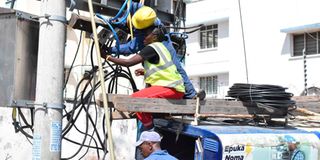Tracing Kenya Power’s dwindling fortunes

Kenya Power staff work on restoring power in the Ganjoni area in Mombasa County on February 9, 2022.
What you need to know:
- Kenya Power was stripped of the role of controlling electricity dispatch to the national grid.
- The government further wants to hand over the role of retail power distribution to households to the Rural Electrification and Renewable Energy Corporation
Kenya Power, the ubiquitous state corporation synonymous with electricity supply to households and businesses, is on the verge of yet another structural surgery that could leave the erstwhile energy giant a pale shadow of its monopolistic years.
It all started with allowing small-capacity firms to obtain licences for localised power distribution.
Next, Kenya Power was stripped of the role of controlling electricity dispatch to the national grid.
Now, the state agency is also set to lose its countrywide retail electricity distribution monopoly.
The restructuring, if effected, will reduce it to just a fraction of what it once was.
Kenya Power, which now has 8.59 million customers, has a long history. Incorporated in 1922 as the East African Power and Lighting Company Limited to serve Kenya, Uganda and Tanzania, it changed its name to the Kenya Power and Lighting Company Limited (KPLC) in 1983.
Faced with mounting pressure to become a more efficient operation, the 100-year-old monopoly is in a defining moment as the government slowly lifts the heavy blankets of legal protection it had accorded it for ages.
Immense pressure
The cost of electricity in Kenya remains punitively high, which has seen the public mount pressure on the government to intervene and lower monthly bills.
The International Monetary Fund (IMF), now an increasingly key lender to Kenya, has mounted immense pressure on the state to undertake drastic reforms at Kenya Power to make it lean, efficient and more reliable.
In 2020, the company made a Sh2.98 billion net loss – its first loss in 17 years – driven by a rapid expansion strategy and runaway corruption.
The monopoly has, since then, heavily relied on state funding for its operations, necessitating reforms that are also aimed at reducing the cost of electricity.
The government made the first major step towards liberalisation of the electricity distribution market by allowing small power producers with a capacity of not more than one megawatt to set up mini-grids in places without connection to the national grid and sell electricity in their localities.
The Energy (Mini-Grid) Regulations 2021 also allowed the firms to buy electricity from Kenya Power and resell it to consumers when the grid finally reaches their areas of operation.
However, the restructuring was barely enough to make a dent in the Kenya Power’s distribution monopoly as more parts of the country are now connected to the grid, lessening the need for mini-grids in many areas.
Another blow to the firm, which is majority-owned by the Treasury, came in January when it was stripped of the key power dispatch role, which was given to the Kenya Electricity Transmission Company (Ketraco).
The Energy and Petroleum Regulatory Authority gazetted Ketraco as the new system operator, enabling it to control the mix of electricity injected into the national grid.
Kenya Power had increasingly come under pressure over the opacity of the power dispatch process that had seen expensive, private-owned power producers prioritised over cheaper electricity sources from wind and the state-owned KenGen.
The Energy Act, 2019, stripped the utility of the role to eliminate conflict of interest by requiring the system operator to be a neutral player not involved in buying or selling of electricity, but its implementation had been delayed.
Kenya Power is also set to be stripped of its electricity transmission mandate leaving Ketraco as the only power transmission firm in the country.
The firm is currently doing both long-distance, high-voltage transmission and distribution of electricity, despite the formation of Ketraco to exclusively undertake this role.
Kenya Power still owns and operates the transmission network that was built decades ago before the establishment of Ketraco.
The government this year said the process will see more than 1,200 staff from Kenya Power transferred to Ketraco.
Handover
The completion of the process is awaiting the conclusion of the valuation of the power transmission assets of the Nairobi Securities Exchange-listed company to complete the transfer.
But the government further wants to hand over the role of retail power distribution to households to the Rural Electrification and Renewable Energy Corporation (Rerec), leaving the firm to only serve large industrial customers.
“Reconfigure KPLC and Rerec across consumer segments so that KPLC is positioned to serve large commercial and industrial consumers, while Rerec is positioned to serve the social mandate for household consumers,” a White Paper published by Energy Principal Secretary Gordon Kihalangwa recommends.
Company officials are, however, content that the move to rid Kenya Power of electricity distribution to households is positive as they contribute to a high proportion of its losses from power theft and unpaid bills.
Commercial consumers remain the company’s bread and butter, constituting about 70 per cent of its annual electricity sales.
The paper also recommends full liberalisation of the power distribution market to allow competition with private firms.
The government wants to utilise the opening up of the market to raise competition, boost efficiency and lower power costs for consumers.
Kenya Power currently loses more than 22 per cent of the electricity it purchases through technical inefficiencies and power theft, a shortfall loaded on to consumers through higher electricity bills.
If all the Energy ministry proposals are implemented, the company risks losing its perch at the centre of Kenya’s vast and lucrative energy ecosystem.





